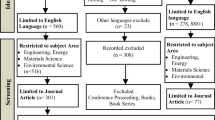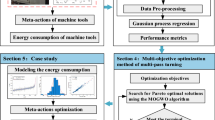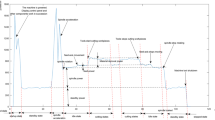Abstract
Intensive appeal for energy saving has driven the production industry towards more environmentally benign manufacturing. Diverse process settings in manufacturing can result in a high variance of energy consumption. Regarding process chains, the allocation of machining stock to each process is very crucial in terms of energy use. Optimization of material stock allowance and process parameters can effectively reduce the production energy. In this study, two cylindrical machining processes—turning and grinding—are compared at machine level with respect to energy intensity and surface roughness. A systematic energy-efficient approach, based on minimizing the production energy while complying with the required surface roughness, has been developed and validated to optimize the grinding stock for the turning-grinding process sequence. Compared to conventional stock allocation method, the developed approach results in more than 16 % of energy reduction for the turning-grinding process.
Similar content being viewed by others
References
Duflou JR, Sutherland JW, Dornfeld D, Herrmann C, Jeswiet J, Kara S, Hauschild M, Kellens K (2012) Towards energy and resource efficient manufacturing: a process and systems approach. CIRP Ann 61(2):587–609
European Commission (2010) Energy—yearly statistics 2008, Eurostat Statistical Books, ISSN 1830-7833
Gutowski T, Murphy C, Allen D, Bauer D, Bras B, Piwonka T, Sheng P, Sutherland J, Thurston D, Wolff E (2005) Environmentally benign manufacturing: observations from Japan, Europe and the United States. J Clean Prod 13(1):1–17
Diaz N, Helu M, Jarvis A, Tönissen S, Dornfeld D, Schlosser R (2009) Strategies for minimum energy operation for precision machining. Proceedings of MTTRF 2009 Annual Meeting
Kara S, Li W (2011) Unit process energy consumption models for material removal processes. CIRP Ann Manuf Technol 60(1):37–40
Mativenga PT, Rajemi MF (2011) Calculation of optimum cutting parameters based on minimum energy footprint. CIRP Ann Manuf Technol 60(1):149–152
Sheng P, Srinivasan M, Kobayashi S (1995) Multi-objective process planning in environmentally conscious manufacturing: a feature-based approach. CIRP Ann Manuf Technol 44(1):433–437
Weinert N, Chiotellis S, Seliger G (2011) Methodology for planning and operating energy-efficient production systems. CIRP Ann Manuf Technol 60(1):41–44
Janakiraman V, Saravanan R (2010) Concurrent optimization of machining processes parameters and tolerance allocation. Int J Adv Manuf Technol 51(1–4):357–369
Halevi G, Weill RD (1995) Principals of process planning—a logical approach, 1st edn. Chapman & Hall, London, ISBN:0412543605
Ren YH, Zhang B, Zhou ZX (2009) Specific energy in grinding of tungsten carbides of various grain sizes. CIRP Ann Manuf Technol 58(1):299–302
Guo Y, Loenders J, Duflou JR, Lauwers B (2012) Optimization of energy consumption and surface quality in finish turning. Procedia CIRP 1:512–517
Klocke F, Brinksmeier E, Weinert K (2005) Capability profile of hard cutting and grinding processes. CIRP Ann Manuf Technol 54(2):22–45
Araujo JB, Oliveira JFG (2012) Evaluation of two competing machining processes based on sustainability indicators. Proceedings of the 19th CIRP Conference on Life Cycle Engineering, pp 317–322
Dahmus JB, Gutowski TG (2004) An environmental analysis of machining. Proceedings of ASME International Mechanical Engineering Congress and R&D Exposition, pp 13–19
Fang XD, Safi-Jahanshahi H (1997) A new algorithm for developing a reference-based model for predicting surface roughness in finish turning of steels. Int J Prod Res 35(1):179–199
Tönshof HK, Peters J, Inasaki I, Paul T (1992) Modeling and simulation of grinding processes. CIRP Ann Manuf Technol 41(2):677–688
Hecker RL, Liang SY (2003) Predictive modeling of surface roughness in grinding. Int J Mach Tools Manuf 43(8):755–761
WNT Deutschland GmbH (2011) Cutting condition for fine machining, Turning Tool Catalogue, pp 210
Duflou JR, Kellens K, Renaldi, Guo Y, Dewulf W (2012) Critical comparison of methods to determine the energy input for discrete manufacturing processes. CIRP Ann Manuf Technol 61(1):63–66
Li W, Winter M, Kara S, Herrmann C (2012) Eco-efficiency of manufacturing processes: a grinding case. CIRP Ann Manuf Technol 61(1):59–62
Author information
Authors and Affiliations
Corresponding author
Rights and permissions
About this article
Cite this article
Guo, Y., Duflou, J.R. & Lauwers, B. Energy-based optimization of the material stock allowance for turning-grinding process sequence. Int J Adv Manuf Technol 75, 503–513 (2014). https://doi.org/10.1007/s00170-014-6139-2
Received:
Accepted:
Published:
Issue Date:
DOI: https://doi.org/10.1007/s00170-014-6139-2




